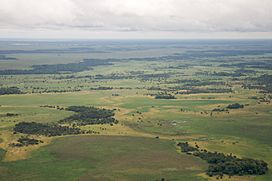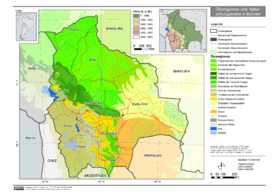Llanos de Moxos facts for kids
Quick facts for kids Llanos de MoxosBeni savanna |
|
|---|---|
 |
|

Map of Bolivia's ecoregions. The Beni savanna is hatched bright green.
|
|
| Ecology | |
| Realm | Neotropical |
| Biome | tropical and subtropical grasslands, savannas, and shrublands |
| Borders | Madeira-Tapajós moist forests and Southwest Amazon moist forests |
| Geography | |
| Area | 125,590 km2 (48,490 sq mi) |
| Countries | Bolivia, Brazil and Peru |
| Departments | Beni |
| Conservation | |
| Conservation status | Critical/endangered |
| Protected | 96,126 km2 (77%) |
The Llanos de Moxos, also known as the Beni savanna, is a large area of tropical grasslands and savannas. It is located in the Beni Department of northern Bolivia. This region is known for its unique environment and ancient history.
Contents
Exploring the Llanos de Moxos Environment
The Llanos de Moxos covers about 126,100 square kilometers (48,700 square miles). Most of it is in northern Bolivia. Smaller parts reach into neighboring Brazil and Peru. This area is in the southwestern part of the Amazon basin. Many rivers from the Andes Mountains flow through it.
Because the land is very flat, about half of it floods every year. This happens during the wet season when it rains a lot and snow melts from the Andes. The Llanos de Moxos is surrounded by thick tropical forests. These include the Southwestern Amazonian moist forests and the Madeira-Tapajós moist forests.
Climate and Seasons
The Llanos de Moxos has a tropical climate. This means it has clear wet and dry seasons. The wet season usually lasts from December to May. During this time, the area gets a lot of rain. Rainfall can range from 1300 mm in the east to 2500 mm in the west.
Plants and Trees of the Llanos de Moxos
This ecoregion is a mix of different landscapes. You can find savannas (grassy plains) and wetlands (swampy areas). There are also small "islands" of forest and forests along the rivers. Flooding and natural fires are very important for how the plants grow here.
Animals of the Llanos de Moxos
The Llanos de Moxos is home to many animals. One special bird found here is the blue-throated macaw (Ara glaucogularis). This beautiful bird is very rare and is considered critically endangered. This means it is at a very high risk of disappearing forever.
Ancient People of the Llanos de Moxos
Long ago, the Llanos de Moxos was home to ancient civilizations. These people lived here before Christopher Columbus arrived in the Americas. They were very skilled farmers. It seems this area was one of the first places where plants were grown on purpose.
The ancient people built amazing earthworks to help with farming. They made raised fields, pathways, and canals. They also built about 4,700 forested mounds. These structures covered a huge area of 50,000 square kilometers. People worked on these projects for a very long time, from about 8850 BCE to 1450 CE.
They grew many important crops. For example, they grew manioc from about 8350 BCE. They also grew squash from about 8250 BCE and maize (corn) from about 4,850 BCE. Many crops we eat today, like manioc, squash, peanuts, some types of chili, and some beans, are very similar to wild plants found in the Llanos de Moxos. This suggests they were first grown here.
These ancient people also made beautiful pottery. They wove cloth from cotton. In some places, they buried their dead in large clay pots called urns.
Europeans first came to South America in the late 1400s. However, they did not settle in the Llanos de Moxos until the late 1600s. In the 17th and 18th centuries, Jesuit missionaries set up missions here. Many of these missions later became the towns we see in the region today.
Since the 1950s, raising cattle has become the main business in the Llanos de Moxos. Cattle ranches now cover much of the landscape.
Jesuit Missions in Moxos
The Jesuit Missions of Moxos are located within the Llanos de Moxos region. There are other famous Jesuit missions, like the Jesuit Missions of Chiquitos, which are in a different area called Chiquitania to the southeast.
Protecting the Llanos de Moxos
It is important to protect the unique environment of the Llanos de Moxos. A study in 2017 found that a large part of this ecoregion is protected. About 96,126 square kilometers, or 77% of the area, is part of protected lands. This helps to keep the plants and animals safe.
See also
 In Spanish: Llanos de Moxos para niños
In Spanish: Llanos de Moxos para niños
- Chiquitania
- Jesuit Missions of Chiquitos
- 1491: New Revelations of the Americas Before Columbus
- Mamoré–Guaporé linguistic area

